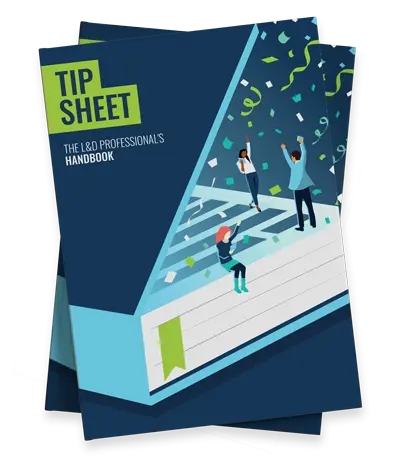
Artificial intelligence (AI) is changing the way we live, work, and learn. To keep pace, learning and development (L&D) professionals must harness the power of emerging tools to drive organisational success. AI prompts are your new secret weapon.
According to the 2024 LinkedIn Workplace Learning Report, 4 in 5 learning professionals want to learn how to use AI at work. Well, we’re here to answer that call. To do this, we’ll be providing actionable AI tips that will help you to elevate your L&D strategy.
One of the most powerful applications of AI for learning professionals is the use of prompts. By carefully crafting these text instructions, you can harness the power of AI to generate content, automate tasks, and gain valuable insights.
This article will provide practical examples and guidance for L&D professionals seeking to optimise their work. Let’s get this prompt party started!
What is an AI Prompt?
In simple terms, an AI prompt is a text-based instruction or query given to an artificial intelligence model to guide its response. It’s the equivalent of giving a specific command to a computer programme, but instead of code, you use human language.
In other words, it’s how we talk to artificial intelligence, to tell it what we want and how we want it. Typically, you’ll be interacting with a large language model (LLM), which is a sophisticated artificial intelligence model trained on massive amounts of data.
These LLMs are capable of responding to your prompts by generating human-quality text, translating languages, writing different kinds of creative content, and answering your questions in an informative way. Examples of LLMs include:
- GPT-4: Developed by OpenAI.
- Gemini: Developed by Google.
- Llama: Developed by Meta.
- Claude: Developed by Anthropic.
What is Prompt Engineering?
Prompt engineering is the ‘art and science’ of designing effective prompts to guide AI models in generating a desired outcome. In effect, it’s like writing precise instructions for a highly intelligent assistant.
Crafting the perfect prompt is an iterative process that demands precision and iteration. To coax the best results from these complex language models, prompt engineers have to meticulously refine their inputs. That’s why their skillsets are valued at a premium.
Learning professionals who embrace prompt engineering will be able to unlock AI’s full potential. As a result, they’ll revolutionise their learning experiences and improve training outcomes.
General Prompt Engineering Tips

As we’ve seen, crafting effective AI prompts is essential for maximising the value of these powerful tools. Before we share some specific examples, let’s explore some general prompting best practice.
- Be Specific: Remember, clarity is paramount. AI models are tools that follow instructions, so the more precise your request is, the better the outcome. Avoid ambiguity and jargon, and ensure your prompt is direct and easy to understand.
- Get Experimental: Prompt engineering is an iterative process. You won’t necessarily get it right the first time. With this in mind, don’t be afraid to experiment with different phrasings, styles, and formats.
- Understand Your AI: Different AI models possess unique strengths, weaknesses, and inherent biases. Tailoring your prompts to your specific model’s capabilities will help to significantly improve your output.
- Provide Examples: Showcasing examples of desired output provides meaningful guidance for your AI model. For instance, if you want the AI to write in a set style, or to use specific formatting, then you should provide a sample.
- Structure Your Prompt: Finally, a well-structured prompt is easier for the AI to process. You should consider breaking your requests down into smaller, more manageable parts and using a logical flow to improve your output.
By following these guidelines, you’ll enhance your ability to create effective AI prompts and achieve better learning outcomes. Need further guidance? Then check out the examples below.
Examples of Good & Bad Prompts
| Bad Prompts | Good Prompts |
| Write something about fish. | Write a story about an overprotective clownfish who embarks on a journey to rescue his captured son. |
| Explain string theory. | Explain string theory in simple terms, as if talking to a 10-year-old. |
| Tell me about the Roman Empire. | Create a timeline detailing the key events that took place within the Roman Empire. |
| Write a poem. | Write a fun limerick about why slow lorises are challenging pets. |
As you can see, the bad prompt examples are typically vague and ambiguous. On the other hand, the good prompt examples provide specific details and context, helping to steer the AI model towards your desired outcome.
How Can AI Prompts Support Learning Professionals?
AI has revolutionised every area of corporate life, and learning and development is no exception. Indeed, by harnessing the power of artificial intelligence, learning professionals can significantly enhance their ability to create effective learning experiences.
We’ve got a full guide on AI-generated learning content. But the utility of a good AI prompt doesn’t stop there. Here are just a few of the ways that artificial intelligence can support learning professionals:
- Personalising Learning Experiences: By tailoring your prompts to individual learners’ needs and preferences, you can deliver highly customised content that’s relevant and goal-orientated.
- Enhancing Your Content: AI models are great for generating ideas, creating outlines, or even drafting content for you. Given the increasing demands on L&D teams, the right prompts can help to save both time and resources.
- Automating Tasks: By automating routine tasks (like course enrollment, certificate generation or learning record management) learning professionals can focus on higher-level activities like engaging their audience.
- Igniting Innovation: Experimenting with different prompts can lead to new and creative approaches to learning and development. It’s like having an endless wellspring of ideas at your fingertips.
- Analysing Data: AI excels at uncovering hidden patterns within vast datasets. Learning professionals can leverage this capability to identify trends, optimise their learning strategy, and make data-driven decisions.
The Top 20+ AI Prompts for Learning Professionals
You’ve made it! In this section, we’ll explore a curated list of the top AI prompts designed to elevate your L&D function. Each prompt will be accompanied by an explanation of its purpose and potential applications.
Of course, this list is not designed to be exhaustive. We encourage you to experiment and innovate to develop your own approaches. Please let us know if you find any prompts that prove to be real game-changers.
Let’s dive in!

1. Establish Your Goal
‘Our main organisational goal is to [goal statement]. Provide a list of skills that employees from [team name] should develop to achieve this’.
By pinpointing the specific skills required to achieve organisational objectives, L&D professionals can strategically align their efforts for maximum impact. This data-driven approach ensures employee development directly supports your business goals.

2. Learner Personas
‘Produce a list of learner personas for [company description]. Consider characteristics such as job roles, departments, skill levels, and learning preferences. Give each persona a distinctive name’.
Here at Growth Engineering, we recommend creating learner personas that give you a better understanding of your target audience. This, in turn, helps you to tailor your learning experiences to their specific needs and preferences.

3. Quiz Generation
‘Create five multiple-choice questions with answer options for a quiz on [topic].’
By automating the creation of multiple-choice questions, learning professionals can significantly streamline their assessment development process. Additionally, AI can generate questions that ensure variety and reduce potential biases.

4. Outline Content
‘Create a detailed outline for an eLearning unit covering [training topic]. It should include a summary of learning objectives, an introduction, a short video, a quiz, and a conclusion.’
Creating content outlines can be time-consuming. Thankfully, AI can generate a basic structure quickly, providing a roadmap for you to work from. The AI may even suggest subtopics and angles that you might not have considered.

5. Script Creation
‘Create a short video script explaining [training topic] in simple terms for an audience of [audience description]’.
Outlines provide a strong foundation, but AI can take content creation a step further. By generating initial scripts or other materials based on specific briefs, learning professionals can significantly streamline their workflow.
Just remember, human oversight is essential!

6. Scenario Development
‘Develop a role-playing scenario for [specific skill] as part of our sales training programme’.
Scenario-based learning is a proven method for enhancing knowledge retention. Unfortunately, it’s not always easy to come up with scenarios that are tailored to specific job roles. Thankfully, AI can generate multiple scenarios quickly, saving time for L&D teams.

7. Seek Feedback
‘Produce a feedback form to evaluate the effectiveness of [training programme]’.
By creating and sharing a feedback form, you can gather valuable insights into the effectiveness of your training programme. This data-driven approach will help you to understand where there are real opportunities for improvement.

8. Implement Feedback
‘Suggest improvement areas for a training programme based on learner feedback’.
Once you have this feedback you then need to decide what to do with it. AI can guide this process by analysing the data and providing useful suggestions. This can help to increase participant satisfaction and improve learning outcomes.

9. Learner Data Analysis
‘Analyse learner data to identify knowledge gaps in [topic]’.
By processing your data, AI can uncover patterns and trends that indicate where learners are struggling. In turn, you can then prioritise your development efforts based on the most critical knowledge gaps.
Please note: While some AI tools might allow direct data upload, others may not have this capability. Where this is not possible, the AI tool may be able to provide valuable insights based on a description of your data.

10. Personalised Learning Plans
‘Create a personalised plan for [employee name] based on their performance data’.
As learning professionals, we understand the importance of a data-driven approach to employee development. By using AI to analyse performance data we can create custom learning paths that are aligned with both individual needs and organisational goals.

11. Curriculum Development
‘Generate a comprehensive learning path for [target audience] on [topic]’.
This prompt provides a structured approach to creating a learning journey for a specific audience. By requesting a comprehensive output, you ensure a thorough exploration of the topic, leaving no essential element overlooked.

12. Check Compliance
‘Develop a checklist for [task] to ensure compliance with [standard name]’.
Compliance training can be a drag, but there’s no getting around it. By creating a checklist, you can provide your employees with clear guidelines and instructions for completing tasks in compliance with specific standards.

13. Create Invites
‘Write a compelling email template inviting employees to participate in a [topic] training programme’.
Maximising enrollment is crucial for the overall success of your training programme. By creating an engaging invite and clarifying the ‘WIIFM’ for your learners, you’re sure to drive employee participation and improve training outcomes.

14. Idea Generation
‘Our company name is [company name] and our mission is [mission statement]. Please create a list of fun potential names for our learning platform.’
As learning professionals, we sometimes forget the value of developing a distinct learning brand. Even something as simple as creating a memorable theme for your learning platform can help to engage your audience.

15. Improve Your Activities
‘Develop three engaging icebreaker activities for a virtual training session on [topic].
Icebreakers help to build rapport and camaraderie among participants, reduce anxiety, and create a sense of community. When these activities are tailored to the training topic at hand they can help to introduce key concepts and generate interest.

16. Build FAQs
‘Create an FAQ document for [topic].’
Training programmes often generate new questions among learners, who may not always have easy access to subject matter experts. Thankfully, an FAQ document can act as a valuable self-service resource for your employees.

17. Simplify Text
‘Simplify the following text for a general audience’.
Learning professionals are used to making sense of technical terms and jargon. But this shouldn’t have to be the case for your audience. Transforming complex information into easily understandable content is one straightforward way to enhance knowledge transfer.

18. Translate Your Content
‘Translate the following text into [language] while considering cultural nuances’.
AI tools empower you not just to translate your content, but also to adapt it in line with specific cultural contexts. This approach fosters inclusivity, promotes understanding, and extends the reach of your training content.

19. Boost Social Learning
‘Develop thought-provoking questions to stimulate discussion on [training topic]’.
According to the 70:20:10 model, social learning makes up 20% of all workplace development. Thanks to AI, you can now get the party started by posing thought-provoking questions and stimulating meaningful discussion.

20. Deeper Learning
‘How do I ensure learners reach the top level of Bloom’s Taxonomy with [training topic]?’.
Bloom’s Taxonomy provides a structured framework for designing learning experiences that promote higher-order thinking skills. By focusing on the highest levels of the taxonomy, you’ll help learners to apply their knowledge in real-world situations.

21. Fun in Learning
‘What ideas can I introduce to make [training topic] more fun and engaging?’
To drive behaviour change, your training must be engaging. AI can supercharge this process by suggesting interactive elements, game mechanics, and storytelling techniques. This ensures learning is both enjoyable and impactful.
Final Words
By mastering the art of AI prompting, L&D professionals can unlock a world of possibilities for creating engaging, effective, and personalised learning experiences. Artificial intelligence is a powerful new ally in achieving your learning goals.
These 20+ examples are just the tip of the iceberg when it comes to the potential of AI prompts in L&D. As AI technology evolves, so too will your ability to push the boundaries of what’s possible.
This means new ways to generate content, automate tasks, and gain valuable insights. With this in mind, we encourage you to embrace experimentation, share your successes, and stay curious about the future of learning. Good luck!
Thanks for reading. We’ve collected further actionable tips to help you get ready for the future of learning in ‘The L&D Professional’s Handbook’. Download it now!









